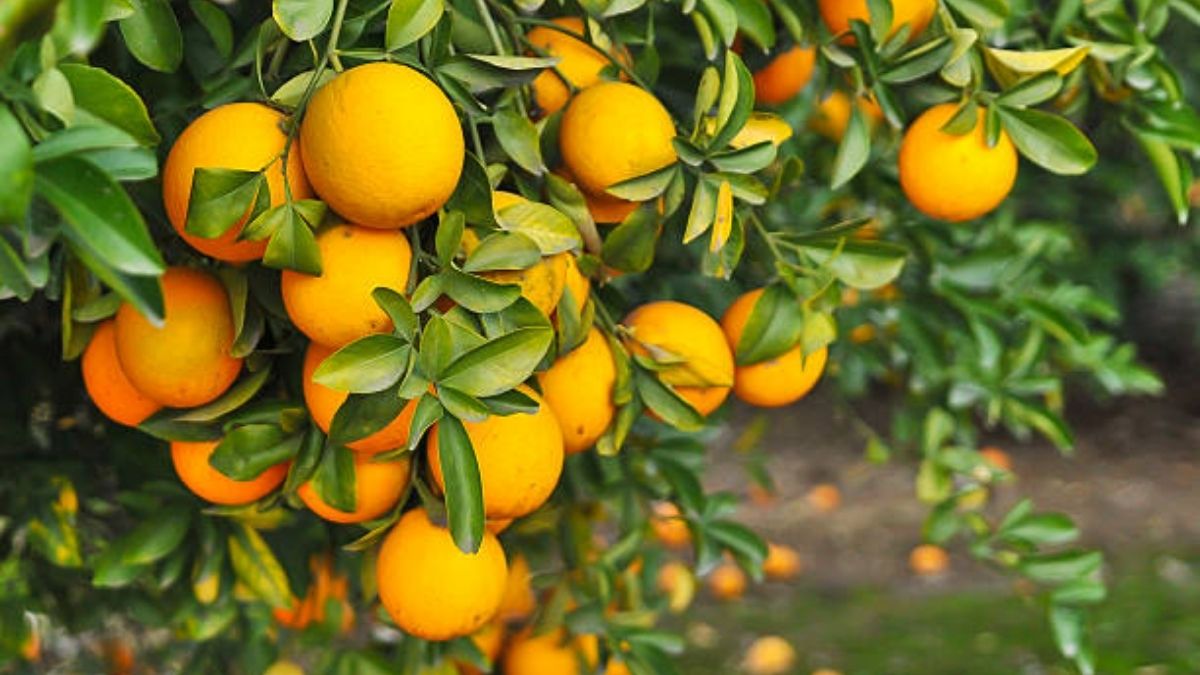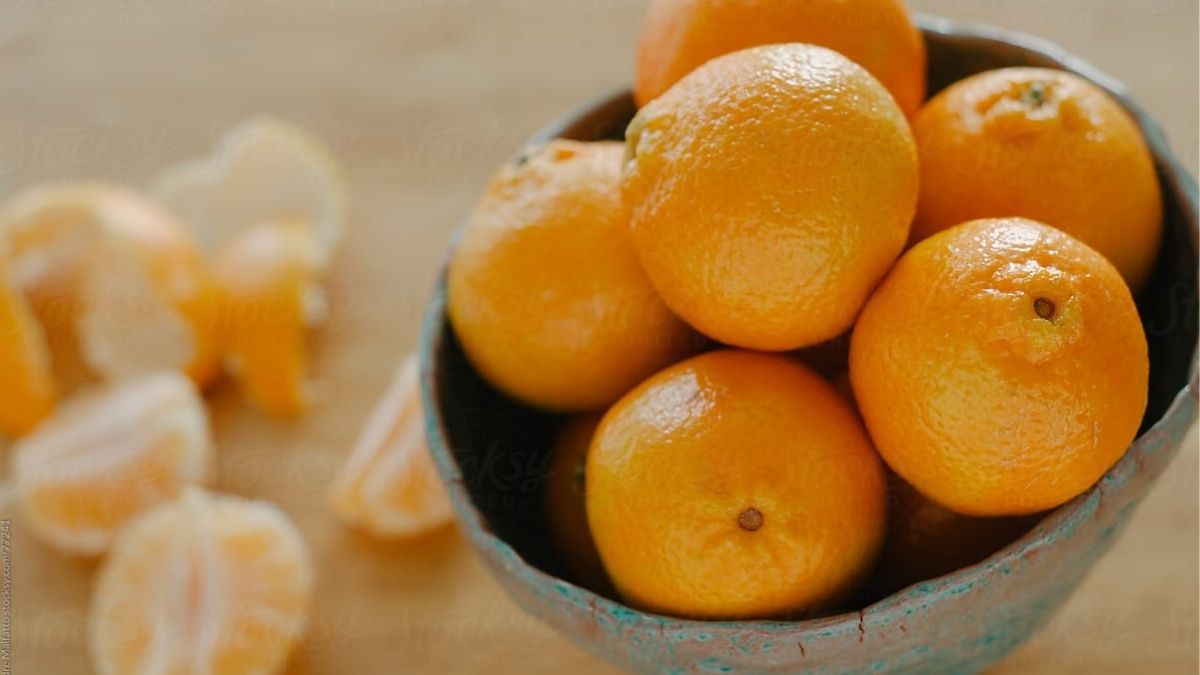Tangelos are a citrus fruit that is a cross between tangerines and grapefruit. Their skin is vivid reddish-orange, and the fruit is sour, acidic, and juicy. They can be eaten raw or used in salads, desserts, and sauces, and they can be juiced. Tangelos, like most tangerines, have that trademark fat nub on the stem end, so it’s no surprise that they’re related to tangerines. Tangelos (Citrus x tangelo; USDA hardiness zones 9 and 10) are a purposeful or accidental cross between any tangerine and a grapefruit or pomelo (the non-hybrid citrus from which modern grapefruits derive). All tangelos – also known as honeybell oranges – are half tangerine and half grapefruit, independent of a cultivar.
Although the tangelo resembles a little orange, it is a citrus hybrid cross between an orange and a pomelo or grapefruit. Tangelos are primarily made from fruits from the Citrus reticulata and Citrus maxima families. This healthy fruit is frequently mistaken for genetically modified, although it results from natural hybridization. Like other citrus fruits, Tangelos have a tart and acidic flavor and are a good source of vitamins.
What are Tangelos?
Tangelos are a citrus fruit of the species Citrus tangelo, which has several subspecies, the most common of which is Minneola, Orlando, Seminole, and others generated by crossing various grapefruit and tangerine cultivars.
Tangelos are spherical to slightly bell-shaped, with a characteristic “nipple” at the end where it joins to the stem. They are three to four inches in diameter or approximately the size of a baseball. They have medium reddish-orange skin and a slightly rough, pebbly texture, making them simple to peel. The fruit is usually seedless, but it may contain up to 20 cream-colored seeds depending on the cultivar. The fruit has ten to twelve portions of soft, luscious flesh with an acidic, tart flavor and medium sweetness.
Tangerine and pomelo, the latter being an ancestral grapefruit variety, were combined to create the term tangelo. They have a medium sweetness, a tart-tangy flavor balance, and can be incredibly juicy. Tangelos are available in the Northern Hemisphere from November through March, with January being the peak month.
Are Tangelos Good for You?
Tangelos are high in dietary fiber and a range of vitamins and minerals. A hybrid between a grapefruit and a tangerine, Tangelos have a high concentration of the same flavonoid chemicals found in other citrus fruits, such as oranges. According to the Centers for Disease Control and Prevention, one medium-sized tangelo provides 1/2 cup of the 2 cups of fruit recommended for adult men and women. A diet rich in the minerals and chemicals found in tangelos may reduce the risk of significant medical disorders. While tangelos are healthy, raw, and cooked, raw consumption retains higher vitamin value. Consult your doctor before incorporating citrus fruits like tangelos into your usual diet if you suffer from indigestion. The acidity of tangelos may irritate the gastrointestinal system lining.
1. Vitamins
Vitamin A, vitamin B-6, riboflavin, thiamine, niacin, folate, and pantothenic acid are all present in tangelos, but they are exceptionally high in vitamin C. For a healthy adult eating a 2,000-calorie diet, one medium tangelo delivers 45 percent of the U.S. Department of Agriculture’s recommended daily amount of vitamin C. Vitamin C may aid in the prevention of hypertension, heart disease, osteoarthritis, and age-related macular degeneration. When exposed to heat, light, or air, vitamin C in foods degrades quickly. To get the most vitamin C out of a tangelo, eat it within three to four days of buying it and keep it in a cold, dark place. To reduce air contact with tangelos, peel them right before eating.
2. Flavonoids
Flavanones, a type of flavonoid chemical, is found in tangelos. According to a 2012 study published in the medical journal “Stroke,” women who ate more citrus fruits like tangelos were 19 percent less likely to have an ischemic stroke than women who ate fewer citrus fruits. The study lasted 14 years and involved roughly 70,000 British women. According to the study, citrus flavanones may have an anti-inflammatory impact that protects blood vessels.
High flavonoid intake may also lessen the risk of aging-related diseases such as asthma, cancer, cardiovascular disease, and neurological problems.
3. Minerals
A medium-sized tangelo has 4% of the daily potassium, calcium, and magnesium requirements. It’s critical to get enough of these minerals to keep your bones and teeth healthy and strong and keep your blood pressure in check. High calcium intake may decrease cholesterol levels, and potassium may assist avoid strokes. Magnesium-rich foods, such as tangelos may help to reduce the risk of diabetes and depression.
Although tangelos only include a trace amount of iron, combining them with high-iron veggies like spinach or other dark green, leafy vegetables will help you receive more iron. The iron in vegetables is not easily absorbed unless consumed with vitamin C-rich food, such as tangelos. For a mineral-rich dinner, toss tangelo slices into a spinach salad.
4. Dietary Fiber

How to Use Tangelos?
Peeling tangelos and snacking on the juicy pieces of fruit within is one of the most significant ways to enjoy them. Tangos are a terrific choice for brown bag lunches, especially for kids, because they are easy to peel.
Tangelos are commonly used raw in green salads, fruit salads, and salsas to accompany fish and shellfish because of their peculiar sweet and tangy flavor. Tangelos can also be juiced, and the juice is used in cocktails, smoothies, dessert sauces, marmalade, and marinades that call for orange juice. Its zest can also be a pleasant substitute for lemon or orange zest in sweet and savory dishes. Even the peel of a tangelo can be candied by simmering it in sugar syrup.
What are the Varieties of Tangelos?
There are several types of tangelos, each of which is a cross between grapefruit and tangerine. The following are some of the most common:
Minneola: A mix between Duncan grapefruit and Dancy tangerine, this is the most popular tangerine kind. Orange flesh with deep red-orange skin. Sweet and tangy in equal measure, with loose, easy-to-remove skin.
Seminole: Bowen grapefruit crossed with Dancy tangerine. Sweet taste with a tangy acidity The “nipple” at the stem end of these tangelos is missing.
Jamaican: The Jamaican tangelo, often known as the Ugli fruit because of its proprietary name, is a naturally occurring combination of grapefruit and mandarin oranges. The skin is a light green color that turns orange as it ripens.
How to Store Tangelos?
In cool or frigid weather, tangelos should be kept dry. Keep them at room temperature for a day or two, or store them in your refrigerator’s crisper drawer on the low humidity setting (i.e., with the vent open) for three to four weeks. Oranges and tangerines keep best in the refrigerator’s crisper drawer, keeping them there to maximum freshness, and fresh oranges can last up to a month in the refrigerator.
Conclusion
It’s no surprise that tangelos are huge fruits, given their grapefruit pedigree. Some grapefruit cultivars are pretty huge. Their skin is usually a vivid orange-red color, and the leaves are brilliant green and waxy, just like most other citrus. Although you can get trees grafted onto a dwarf or semi-dwarf rootstock, which results in a lovely, compact tree suited for backyard gardens, around 5 to 7 feet tall and broad, most tangelos can grow 20 to 30 feet tall and 15 to 25 feet wide.
Tangelos are available in grocery store fruit sections and at farmers’ markets throughout the late fall and early winter. Look for a firm to slightly softer ones that are substantial for their size and have a brilliant orange-red hue. Tangerines have a sweet-tart flavor that comes from the honey sweetness of the tangerines combined with the acidity and floral notes of the grapefruit. The fruit has a medium to low acidity and is delicious.

